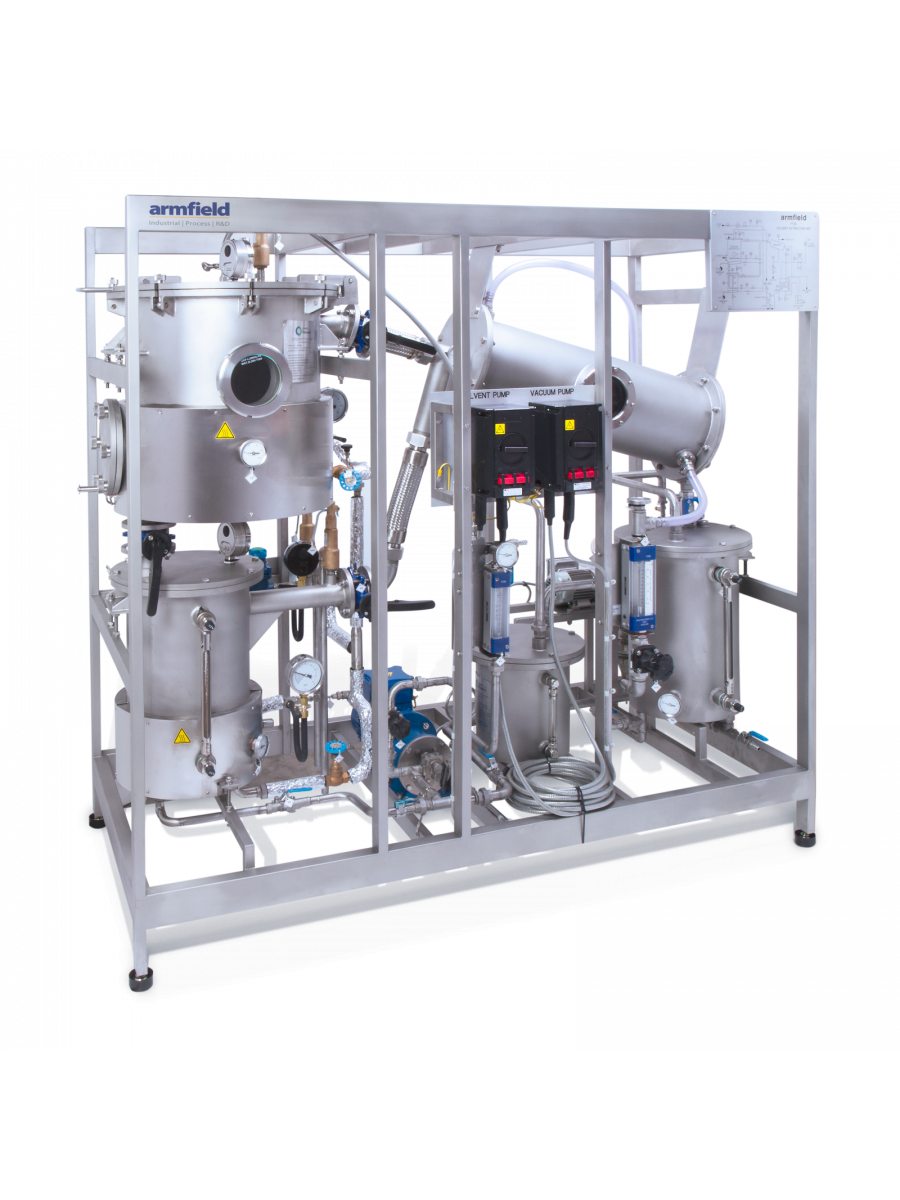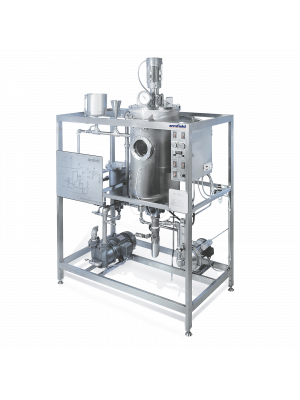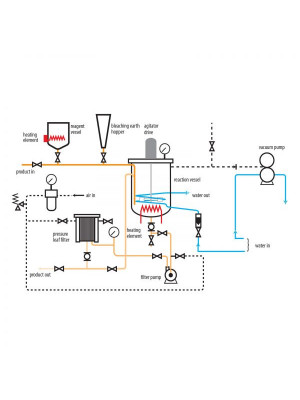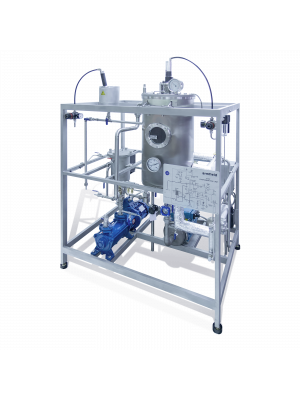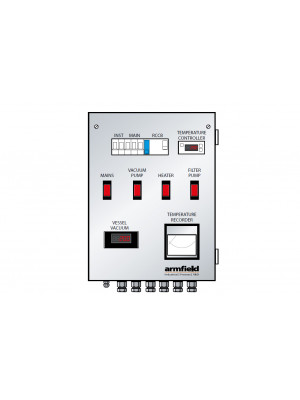Chargen-Lösungsmittel-Extraktionseinheit
- Verfügbarkeit Auf Bestellung
- Hersteller Armfield
- Artikelnr. FT29
- Produkt angesehen: 31586
Teilen:
Chargen-Lösungsmittel-Extraktionseinheit
FT29 Batch-Prozess Fest/Flüssig-und Lösungsmittel-Extraktionseinheit
Die FT29 ist eine Batch-Prozess-Einheit für Forschung und Lehre. Sie ist in der Lage, eine Vielzahl von Fest / Flüssig-Extraktionen durchzuführen und ist besonders geeignet für die Auslaugung von Speiseölen, die aus Samen gewonnen werden sowie die Lösungsmittelextraktions extrahierter Feststoffe und Miscella.
Features
• Fully self contained system
• Floor Mounted
• Single extraction/desolventiser vessel
• Miscella tank
• Tops condensor
• Solvent/water recovery tank
• All flame proof construction
Benefits
> Operation of small-scale version of industrial processes
> A wide variety of solid/liquid extractions may be processed
> Small quantities (25 kgs) can be processed
> Low disposal rates
Description
All vessels, pipes, valves and fittings in contact with process materials are constructed in stainless steel with the exception of the borosilicate glass solvent condenser. The support framework is also stainless steel.
Schematic diagram
of the FT29
 enlarge
enlarge
The cylindrical extractor/desolventiser with a hinged lid for charging the extraction material, has a base inclined slightly towards a port for discharging the extracted and desolventised meal. Material is supported above the base by a perforated plate covered with a fine woven mesh so solvent may drain through to the miscella tank whilst retaining the solids. The vessel base is equipped with an indirect steam chest for process heating. Direct steam is injected at a variable rate through a distribution pipe positioned above the mesh. A similar distribution pipe positioned near the top of the vessel allows solvent to be sprayed uniformly onto the bed of material. The miscella tank, positioned directly below the extractor to collect the draining liquid, is also a cylindrical vessel incorporating a steam chest as its base.
This vessel also incorporates a direct steam distribution pipe through which steam can be metered at a variable rate. Vapour from the vessels, produced in the desolventising process,is directed by ducting to the solvent condenser, an inclined cylindrical glass tube containing a double coil through which cooling water is circulated. Condensate (usually a mixture of solvent and water) drains into the solvent water separator tank which allows thorough separation of the solvent and water by a gravity process.
(Note: Only hexane or solvents having a similar specific gravity can be effectively separated in this tank).
Solvent reclaimed from this vessel can then be recirculated by the solvent pump at a regulated rate through a variable area flow meter. Excess water overflows to a waste water tank from where it can be disposed of on completion of the process. Operation at reduced system pressures are achieved by a PTFE diaphragm type vacuum pump. The outlet of this pump is piped through a flame arrester to a suitable ventilation point. Each vessel is equipped with suitable level/sight glasses so that the processes can be observed and monitored. Pressure and temperature gauges are supplied where necessary as are adequate sampling and drain valves.
Inspecting the interior of
the extractor vessle
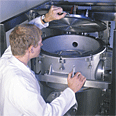 enlarge
enlarge
Hexane is the most widely used solvent in the extraction process and, due to the inflammable nature of this product, electrical equipment has been kept to a minimum. Where electrical equipment must be used, it is specified to the appropriate standards for safety.
The main processing vessels have been designed in accordance with the appropriate code of practice for welded pressure vessels.
Modes Of Operation
Extraction by Recirculating Miscella
This
involves priming the miscella tank with clean solvent then pumping the
solvent to the extractor where it percolates through the material bed
and drains as miscella back into the tank for recirculation.
Extraction by Washing with Clean Solvent
As
miscella is formed, steam admitted to the miscella tank base causes
solvent to evaporate. The vapour is condensed in the solvent condenser
and returns to the separator tank from which it is pumped back to the
extractor.
Desolventising Extracted Material
When
the extraction is complete, the static hold-up of solvent remaining in
the material must be removed and this is achieved using a combination of
direct and indirect steam and vacuum. The solvent vapourises and is
condensed along with the direct steam and the condensate. The mixture of
solvent and water is separated in the solvent water separator tank.
When the extracted material is free of solvent it is discharged through
the door at the base of the extractor.
Desolventising Miscella
Miscella is a
mixture of the solvent and oil from the extraction material which
accumulates in the miscella tank during the process. The solvent and oil
are separated in a similar method as for material desolventising using a
combination of direct and indirect steam and vacuum.
A higher level of vacuum is required than for material desolventising in order to produce solvent-free oil.
Within each mode of operation, many operating parameters such as process temperature, solvent temperature, solvent flow rate, direct steam flow rate and system pressure can be adjusted to allow a high degree of experimentation.
Some Examples of Extractions Possible Using the FT29
| Extraction material | Extract | Solvent |
|---|---|---|
| Oilseeds/presscakes | Edible oil | Hexane |
| Tree bark | Tannin | Water |
| Solanium (a grass) | Steroid | Dil. sulphuric acid |
| Pyrethrum flower | Insecticide | Hexane |
| Tea leaves | Tea | Water |
| Wheat germ | Oil | Hexane |
| Rice bran | Oil | Hexane |
| Poppy stalks | Morphine | Water |
| Flowers/fruits | Essential oils | Hexane |
| Liquorice roots | Liquorice juice | Water |
Capabilities
> effect of degree of pretreatment of solid material on extraction efficiency
> effect of solvent type
> effect of solvent percolation rate
> effect of process temperature and pressure
> effect of extraction time and drain time
> method and degree of solvent recovery.
Unit Specifications
Extractor Vessel:
Volume: 100 litres
Batch capacity: 25kg based on density of 560kg/m3
Direct steam: 0 - 7 kg/hr
Indirect steam: 0 - 3.5 bar
Miscella Tank:
Volume: 30 litres
Minimum extract: 2 litres
Direct steam: 0 - 4kg/hr
Indirect steam: 0 - 3.5 bar
Solvent Condenser:
Condensing capacity: 2.5kW
Condensing area: 2.5m2
Cooling medium: water
Cooling water flow range: 0 - 22 l/m
Solvent Water Separator Tank:
Volume of separator section:16 litres
Volume of solvent store section:16 litres
Waste Water Tank:
Total volume: 15 litres
Vacuum Pump:
Type: Double PTFE diaphragm
Drive: Flameproof a.c. motor
Operating pressure: 100mbar (max).
Solvent Pump:
Type: Gear
Drive: Flameproof a.c. motor
Solvent flow range: 0-8lpm with by-pass flow control.
Requirements
Electricity
FT29-C: 415V/3ph/50Hz, (0.6kW)
FT29-D: 208V/3ph/60Hz, (0.6kW)
FT29-E: 380V/3ph/50Hz, (0.6kW)
FT29-F: 220V/3ph/60Hz, (0.6kW)
Cooling Water
25 l/m @ 3.0 (min) - 5.0 (max) bar pressure.
Steam Supply
20kg/hr @ 5.0 bar min. pressure
Shipping Specification
Overall volume: 5.8m³
Overall weight: 880kg
Overall Dimensions
Height: 1.75m
Width: 1.90m
Depth: 0.90m

